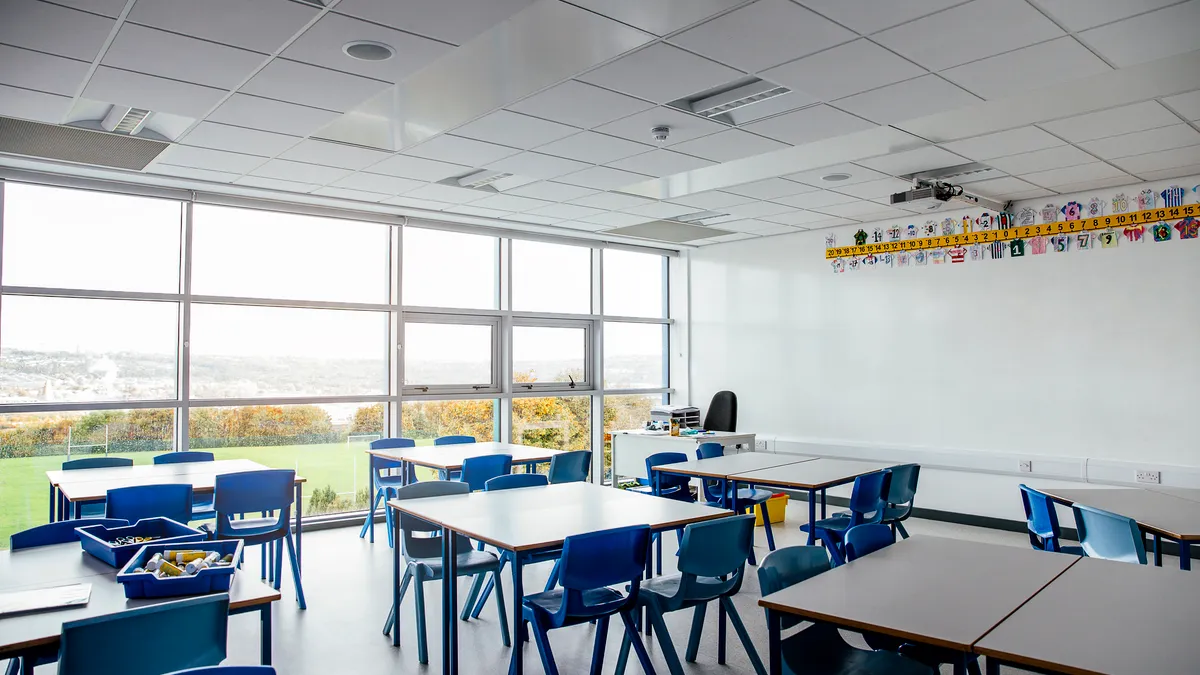Dive Brief:
- The U.S. Department of Energy’s Efficient and Healthy Schools program recognized 13 U.S. school districts during the White House Summit for Sustainable and Healthy K-12 Buildings and Grounds in April.
- The program has 202 participants from schools and districts in 45 states, representing over 5 million students and over 8,400 schools. The recognition, announced by Deputy Secretary of Energy David Turk, offers an opportunity to showcase best practices and case studies for other school districts that are looking for peer guidance — with submissions evaluated on their approach, outcomes, impacts, replicability, education and workforce training, DOE said in an April 29 news release.
- In addition to energy efficiency and sustainability benefits, retrofitting school buildings and grounds can bolster indoor air quality and provide health benefits to students, improving productivity and reducing absenteeism, Sumayyah Theron, CEO and founder of Avant-garde Sustainable Solutions, told Facilities Dive.
Dive Insight:
The average main instructional school building in the U.S. is about 49 years old, with 38% built prior to 1970, according to a survey by the National Center for Education Statistics. While the White House Summit primarily focused on energy efficiency and sustainability efforts in school districts, there is a concurrent nationwide push to improve the health of these spaces.
This trend is partly driven by a growing consensus among experts on the need to improve ventilation rates beyond the minimum “acceptable” targets promoted over the past two decades. Research indicates that improving indoor air quality can reduce exposure to respiratory pathogens and enhance cognitive function performance.
“If you have really bad indoor air quality, it can affect your mental well-being. It affects your health. It could affect your concentration and it could cause long-term illnesses like asthma and heart disease,” Theron said, noting that deteriorating IAQ can lead to increased absenteeism in schools. “Because if you're in a space and you have a headache [and] you feel tired or…sluggish, you're not going to concentrate on your exam,” Theron added.
Theron recently led an initiative in partnership with digital data company Attune and ASHRAE at McClure Junior High and Forest Hills Elementary School in Western Springs, Illinois, which seeks to install air monitors at the school facilities, according to CBS News. The monitors can detect carbon dioxide, ozone and other particles that can carry pathogens like COVID-19, CBS News reported. These systems will both monitor the schools and teach students on how to track the air quality data online, Theron said.
Theron noted that this initiative addresses a significant challenge in facilities management, which involves effectively handling the large amount of data collected from sensors. “Basically, [operators] really don't know how to process the data. A lot of times there is too much information. And there is so much out there, there's so much noise,” Theron said. “So, see what is the best out there that works really well with your building. Having sensors and monitors in the space really can tell you how that plays and how the space is functioning.
“You can tell where the people are gathering, and how the parameters are moving in different spaces. When you really can track everything, you can have a better picture. When you see it, you can control it,” Theron added.
At the White House Summit, Turk underscored that applications are open for the 2024 Renew America’s Schools Prize, which will award an anticipated $180 million to K-12 public schools across the country. The three-phase opportunity will help districts build capacity, perform energy audits, and plan and implement energy improvement projects across school facilities, per DOE’s news release. Applications are due June 13.
This year’s Efficient and Healthy Schools program honorees include the Boise School District in Idaho; Broward County Public Schools in Florida; Canajoharie Central School District in New York; Hamilton Southeastern Schools in Indiana; IDEA Public Schools in Texas; Lansing Public School District and Livonia Public Schools in Michigan; Loudoun County Public Schools in Virginia; School District of Neillsville in Wisconsin; Porterville Unified School District in California; Portland Public Schools in Oregon; River Trails School District #26 in Illinois; and Seattle Public Schools in Washington.
The DOE noted that 70% of the schools in the program are eligible for federal financial assistance through Title I. The federal program is part of the Elementary and Secondary Education Act and aims to provide financial assistance to local educational agencies for low-income families to ensure that all children have access to high-quality education, according to NCES.









 Dive Awards
Dive Awards





